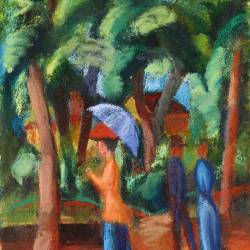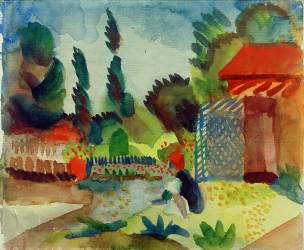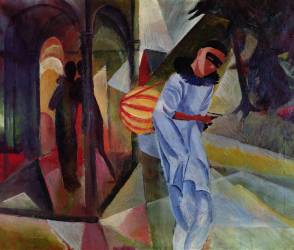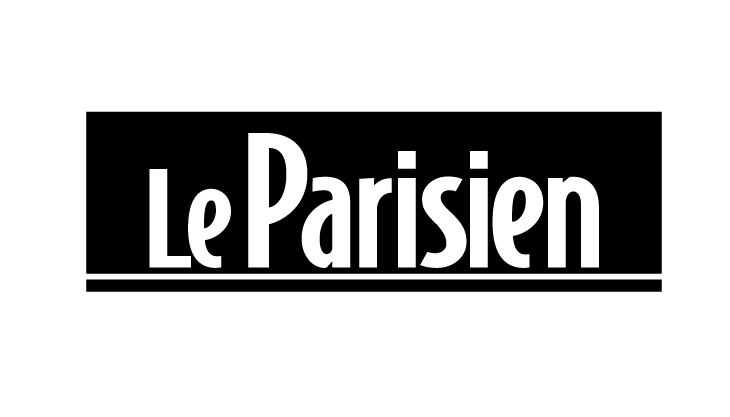Artwork of August Macke drawings & artprints
August Macke, a major figure in modern German art, led a brief but intense life, marked by a constant search for light and colour. Born in 1887, this expressionist painter, a member of the famous Blue Rider group (Der blaue Reiter) alongside Kandinsky and Klee, distinguished himself with a singular expressionist style, tinged with fauvism through to cubism. His travels, particularly to Tunisia with Paul Klee and Louis Moilliet in 1914, were a profound source of inspiration, giving rise to luminous, vibrant works. Canvases such as Promenade and Formes colorées I and II bear witness to his fascination with the theme of the garden, scenes from everyday life and the representation of movement through vibrant interplays of colour.
Discover August Macke's finest works, with Young Girls Under the Trees, an oil on canvas depicting a genre scene, a style the painter favoured; Landscape with Three Young Girls, an oil painting resulting from Macke's research into Fauvism; Promenade, a painting influenced by his discovery of Delaunay's work; and his paintings Colourful Forms I and II, two abstract works following on from his research within the "Der blaue Reiter" movement.
Get yourself a reproduction of the works by August Macke available in the catalogue, and discover the life of one of the major painters of modern art and German expressionism.
Biography of August Macke
August Macke's youth and education
August Macke was born in Meschede in Westphalia in 1887. His father, August Friedrich Hermann Macke, a civil engineer, had a real passion for art and music, influencing young August from an early age. The family later moved to Cologne and then Bonn, where the future artist spent most of his youth.
At the age of 13, August Macke immersed himself in the world of the arts. He took a particular interest in drawing and oil painting and became fascinated by the luminous symbolist canvases of Arnold Böcklin, which he discovered on a trip to Basel in 1900, and which influenced his first paintings.
Little inclined towards classical schooling, in 1904 he entered the Academy of Fine Arts in Düsseldorf, attended evening classes at the School of Decorative Arts, in which the freedom of subject matter was greater, and then joined the School of Applied Arts in order to complete his training.
Eager to discover new things, the young artist took his first trip to Paris in 1903, where he discovered Impressionism, which would shape his artistic vision. Returning to Paris in 1907, this stay in the French capital was decisive: he discovered the works of Gauguin and van Gogh, with the bold colour of Fauvism making a profound impression on him.
The pencil and oil on cardboard sketch painted en plein air, Tree in a Wheatfield, bears witness to his apprenticeship and fascination with colour at this period.
Early career and influences of August Macke
Germany at the beginning of the twentieth century was in the midst of an artistic ferment. At this time, August Macke was taking his first steps on the art scene. The paintings of this promising young artist quickly attracted attention and helped to forge a name for him among the many artists of the time.
In 1909, Macke married Elisabeth Gerhardt, whom he had met at school in 1903, and who was to become his muse and a constant source of inspiration. The couple settled on the banks of Lake Tegernsee, a peaceful and picturesque place that would feed the painter's imagination.
Macke, influenced by Lovis Corinth, whose freedom of style and expressive power he admired, and with whom he had briefly stayed in Berlin, was also interested in Fauvism and the beginnings of Expressionism, movements that advocated the bold use of colour and the simplification of form.
During this period, influenced by Cézanne and Matisse, Macke repeatedly painted portraits of his wife, as well as luminous, colourful landscapes. Among his notable paintings from this period are The Staudacher House in Tegernsee, Tegernsee Landscape, Children in the Garden, Lake Tegernsee Sailboat, and Couple in the Forest. These paintings testify to his fascination with nature and everyday life, and mark an important stage in the development of his art. In 1911, the couple left Tegernsee and moved to Bonn, where Macke continued to explore new artistic avenues and socialise with other major artists of his time.
August Macke's participation in the Blue Rider movement (Der Blaue Reiter)
In 1911, August Macke met Franz Marc, a key moment that linked him to the Blue Rider movement (Der Blaue Reiter). He soon became close to the group's artists, particularly Kandinsky, with whom he shared a vision of art in which colour was paramount. Macke actively participated in the Blue Rider exhibitions, showing his paintings alongside those of Vassily Kandinsky, Franz Marc and Paul Klee.
His canvases, vibrant and luminous, bear witness to a search for harmony of colour and simplification of form. This chromatic mastery can be seen in Garden by Lake Thun, where the intensity of the colours structures the composition. Macke also contributed to the Blue Rider almanac, a collective work that brought together pages of writings and reproductions of works, reflecting the diversity of styles and arts within the movement.
Despite his participation in the Blue Rider, Macke retained a certain independence and developed his own pictorial language, incorporating Expressionist influences from Cubism and Futurism, without however entering into total abstraction.
August Macke's expressionism, and breakthroughs towards abstraction
In 1913, Macke distanced himself from the Blue Rider movement, whose members he humorously caricatured in his painting Caricature of the Blue Rider. His expressionism was then tinged with a more personal touch. While his paintings, such as Young Girls Under the Trees, retain a certain figuration, they are characterised by a simplification of forms and an intensification of colours.
The trip to Paris in 1912 and the discovery of Robert Delaunay marked a turning point. Macke was fascinated by Orphism, the movement that explored light and colour, and applied it to his own research. Promenade (with a bust of a young white girl) illustrates this growing influence. The shapes become geometric, the colours intensify, heralding a breakthrough towards abstraction.
In Women in Front of a Hat Shop, Macke plays with contrasts and flat areas of bright colour. His Formes colorées I and II, or his painting Au bord du lac bleu, bear witness to this exploration of abstraction, where forms dissolve in a play of colour and light.
North Africa and Tunisia, a landmark trip for August Macke
In 1914, August Macke undertook a seminal trip to Tunisia with his painter friends Paul Klee and Louis Moilliet. This stay in North Africa marked a turning point in his work, particularly through the profound influence of the light and vibrant colours of the region.
In Tunis, then in Saint-Germain (Ezzahra), Hammamet and Kairouan, Macke tried his hand at watercolour and painted numerous canvases, capturing the unique atmosphere of these places. In Paysage africain and Paysage des environs de Hammamet, the intense light of the African sun is reflected in flat expanses of vivid colour and marked contrasts.
Tunisian architecture and everyday scenes also inspire him. The interior courtyard of the Saint-Germain house near Tunis testifies to his interest in patios, the garden theme and the play of light and shadow.
He was also a great fan of the Tunisian landscape.
On his return to Munich, Macke transposed this influence into a more familiar setting with Café turc I and Café turc II, in which we find the intensity of colour and simplification of form observed in Tunisia. His quick, spontaneous watercolour technique captures the very essence of his subjects, whether landscape, portrait or street scene.
Last works by August Macke and untimely death
Returning from his trip to Tunisia in 1914, August Macke, inspired by the light and vibrant colours of Tunis, produced several major works. These included oil-on-canvas paintings such as Women in a Park and Red House in a Park, in which he experimented with new colour harmonies and simplified forms. Jeune Fille avec des poissons dans un récipient de verre (Young Girl with Fish in a Glass Vessel) shows an Eastern influence in the treatment of decorative motifs. A watercolour, Mother and Child in Kairouan Park III, now in the Westfälisches Landesmuseum für Kunst und Kulturgeschichte, also bears witness to this fertile period.
Unfortunately, the First World War broke out and Macke was mobilised. He then painted Adieu, a poignant work charged with emotion, which tragically foreshadowed his demise. In September 1914, aged just 27, he died at the front, leaving behind him an unfinished body of work, but one rich in immense talent. His pictorial explorations, particularly those undertaken as part of his Tunisian trip, heralded a promising development that was brutally interrupted.
The legacy of August Macke
Although his life was brought to an abrupt end by the war, August Macke's influence on modern art is undeniable. His paintings, vibrant with colour and light, explore everyday themes with a unique sensitivity, from portraits to landscapes to everyday scenes. The influence of Fauvism and Cubism can be seen in his work, but Macke developed his own personal style, particularly during his trip to Tunisia with Paul Klee and Louis Moilliet. This trip marked a turning point in his work, with the African light intensifying his palette and liberating his compositions. A member of the expressionist movement Der Blaue Reiter (the Blue Rider), he shared with his contemporaries, notably Franz Marc and Wassily Kandinsky, the desire to transcend visible reality to achieve a spiritual dimension through art.
While the war tragically ended his career, his canvases continued to inspire. Macke influenced generations of artists, in Germany and internationally, and his works are now exhibited in the greatest museums. Die Brücke, another major group of German expressionists, also recognised the importance of his contribution to modern art, integrating his pictorial styles into their own research. Macke's posthumous recognition has manifested itself in numerous major exhibitions celebrating the strength and originality of his work.
Learn more about the life and the works of August Macke.


























































































































